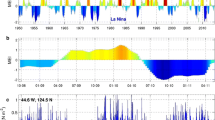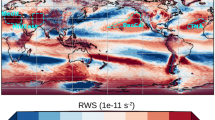Abstract
In winter, northeastern North America and northeastern Asia are both colder than other regions at similar latitudes. This has been attributed to the effects of stationary weather systems set by elevated terrain (orography)1, and to a lack of maritime influences from the prevailing westerly winds2. However, the differences in extent and orography between the two continents suggest that further mechanisms are involved. Here we show that this anomalous winter cold can result in part from westward radiation of large-scale atmospheric waves—nearly stationary Rossby waves—generated by heating of the atmosphere over warm ocean waters. We demonstrate this mechanism using simulations with an idealized general circulation model3,4,5, with which we show that the extent of the cold region is controlled by properties of Rossby waves, such as their group velocity and its dependence on the planetary rotation rate. Our results show that warm ocean waters contribute to the contrast in mid-latitude winter temperatures between eastern and western continental boundaries not only by warming western boundaries, but also by cooling eastern boundaries.



Similar content being viewed by others
References
Seager, R. et al. Is the Gulf Stream responsible for Europe's mild winters? Q. J. R. Meteorol. Soc. 128, 2563–2586 (2002)
Hartmann, D. L. Global Physical Climatology (Academic Press, 1994). Ch. 7.4.
Frierson, D. M. W., Held, I. M. & Zurita-Gotor, P. A gray-radiation aquaplanet moist GCM. Part I: static stability and eddy scale. J. Atmos. Sci. 63, 2548–2566 (2006)
Frierson, D. M. W. The dynamics of idealized convection schemes and their effect on the zonally averaged tropical circulation. J. Atmos. Sci. 64, 1959–1976 (2007)
O'Gorman, P. A. & Schneider, T. The hydrological cycle over a wide range of climates simulated with an idealized GCM. J. Clim. 21, 3815–3832 (2008)
Held, I. M. in Large-scale Dynamical Processes in the Atmosphere (eds Hoskins, B. & Pearce, R. ). 127–168 (1983)
Held, I. M., Ting, M. & Wang, H. Northern winter stationary waves: theory and modeling. J. Clim. 15, 2125–2144 (2002)
Hsiung, J. Estimates of global oceanic meridional heat transport. J. Phys. Oceanogr. 15, 1405–1413 (1985)
Smagorinsky, J. The dynamical influence of large-scale heat sources and sinks on the quasi-stationary mean motions of the atmosphere. Q. J. R. Meteorol. Soc. 79, 342–366 (1953)
Hoskins, B. J. & Karoly, D. J. The steady linear response of a spherical atmosphere to thermal and orographic forcing. J. Atmos. Sci. 38, 1179–1196 (1981)
Held, I. M. & Ting, M. Orographic versus thermal forcing of stationary waves: the importance of the mean low-level wind. J. Atmos. Sci. 47, 495–500 (1990)
Lau, N. C. The observed structure of tropospheric stationary waves and the local balances of vorticity and heat. J. Atmos. Sci. 36, 996–1016 (1979)
Grose, W. L. & Hoskins, B. J. On the influence of orography on large-scale atmospheric flow. J. Atmos. Sci. 36, 223–234 (1979)
Cook, K. H. & Held, I. M. The stationary response to large-scale orography in a general circulation model and a linear model. J. Atmos. Sci. 49, 525–539 (1992)
Pedlosky, J. Geophysical Fluid Dynamics 2nd edn (Springer-Verlag, 1987)
Schneider, T. & Walker, C. C. Self-organization of atmospheric macroturbulence into critical states of weak nonlinear eddy–eddy interactions. J. Atmos. Sci. 63, 1569–1586 (2006)
Lighthill, M. J. On waves generated in dispersive systems by travelling forcing effects, with applications to the dynamics of rotating fluids. J. Fluid Mech. 27, 725–752 (1967)
Rhines, P. B. in Dynamics in Astrophysics and Geophysics (ed. Lebovitz, N. R. ). 3–58 (1983)
Rhines, P. B. Rossby Waves, Encyclopedia of Atmospheric Sciences (Academic Press, 2002)
Rhines, P. B. Jets and orography: idealized experiments with tip jets and Lighthill blocking. J. Atmos. Sci. 64, 3627–3639 (2007)
Kaspi, Y. & Schneider, T. Downstream self-destruction of storm tracks. J. Atmos. Sci. (in the press). (2011)
Kalnay, E. et al. The NCEP/NCAR 40-year reanalysis project. Bull. Am. Meteorol. Soc. 77, 437–470 (1996)
Acknowledgements
We thank D. Abbot, I. Eisenman, X. Levine and T. Merlis for comments. This research was supported by the National Oceanic and Atmospheric Administration Climate and Global Change Postdoctoral Fellowship administered by the University Corporation for Atmospheric Research (Y.K.), by a David and Lucile Packard Fellowship (T.S.), and by a grant from the National Science Foundation (AGS-1019211). The simulations were performed on the California Institute of Technology's Division of Geological and Planetary Sciences Dell cluster.
Author information
Authors and Affiliations
Contributions
Y.K. and T.S. designed the study and wrote the paper; Y.K. performed the numerical simulations and data analyses.
Corresponding author
Ethics declarations
Competing interests
The authors declare no competing financial interests.
Supplementary information
Supplementary Figures
The file contains Supplementary Figures 1-2 with legends. (PDF 259 kb)
Rights and permissions
About this article
Cite this article
Kaspi, Y., Schneider, T. Winter cold of eastern continental boundaries induced by warm ocean waters. Nature 471, 621–624 (2011). https://doi.org/10.1038/nature09924
Received:
Accepted:
Published:
Issue Date:
DOI: https://doi.org/10.1038/nature09924
- Springer Nature Limited
This article is cited by
-
Explosive and binary cyclogenesis over a mid-latitude hotspot and its Rossby number dependence in an idealized general circulation model
Climate Dynamics (2024)
-
Multiple drivers of the North Atlantic warming hole
Nature Climate Change (2020)
-
Remote sensing linear trends of the Gulf Stream from 1993 to 2016
Ocean Dynamics (2020)
-
Northern Hemisphere Stationary Waves in a Changing Climate
Current Climate Change Reports (2019)
-
Challenges and opportunities for improved understanding of regional climate dynamics
Nature Climate Change (2018)





